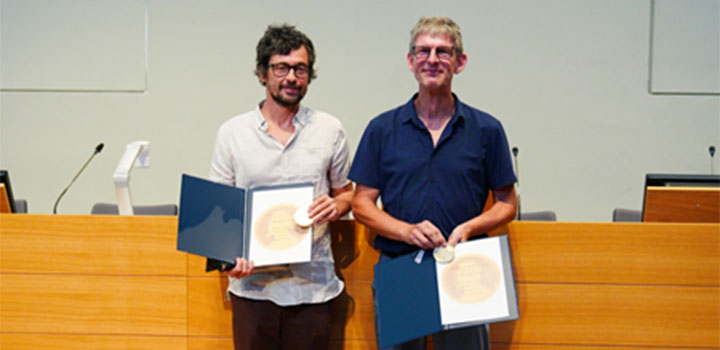UEA mathematician wins Hausdorff medal
By: Communications

David Asperó researches set theory, which is a very abstract area in pure mathematics, usually classified as part of mathematical logic. The objects of study in set theory are the collections, or sets, of mathematical objects. The focus is usually on infinite sets, and in fact set theory is the area of mathematics dealing most directly with the various types, and sizes, of infinity to be found in mathematics. Set theory serves as a standard foundation for all, or most, of mathematics and it is itself a deep area of mathematics.
David said: "A few months ago, my friend and co-author Ralf Schindler and I were awarded the Hausdorff medal. This is perhaps the most prestigious prize in set theory, awarded every two years by the European Set Theory Society for the best work in set theory published within the last 5 years. The winner is decided on the basis of the votes of the members of this Society.
"The prize was given to Schindler and I for our joint paper “Martin’s Maximum++ implies Woodin’s axiom (*)”, which was published last year in the Annals of Mathematics. The Annals of Mathematics is perhaps the top research journal in pure mathematics. It was a great accomplishment for us to publish in this journal, and it was a true honour to receive the Hausdorff medal.
"There is no doubt that our work, which solved a famous problem in the area open since the 1990’s, is of a very high quality. On the other hand, I would like to also point out the role played by some extraneous factors in us getting this prize. By this I want to say that we were very lucky that our work has obtained a great and unusual deal of visibility throughout last year, starting with the publication of an article in Quanta magazine shortly after our paper appeared in the Annals of Math. in May 2021. In fact, last year I have seen an unusual avalanche of interest in our result by many people outside the community. One of the main reasons why this happened is, I think, the fact that our result had just appeared in one of the top journals in mathematics - which made it be perceived as something deep and serious - while at the same time it ultimately deals with an intriguing-sounding but simple question - namely, “exactly how many real numbers are there?”. This question, by the way, stems from the very beginnings of set theory, in the late 19th century."
Related Articles

UEA part of EDI sharing hub to use collective knowledge to address diversity challenges
A new national hub will harness the engineering, physical and mathematical sciences (EPMS) research and innovation community’s collective effort to address diversity challenges specific to the sector.
Read more
Innovation and Impact Awards now open for entries and nominations
The Innovation and Impact Awards are back for 2025 and looking to recognise and reward UEA’s most game changing staff, students, and graduates, and their collaborative work with partners outside the University.
Read more
UEA academic receives award from the Royal Meteorological Society
Daniel Skinner, Senior Research Associate based in the Climatic Research Unit at the University of East Anglia (UEA) has been named the newest recipient of The Malcolm Walker Award for New Environmental Researchers by the Royal Meteorological Society.
Read more